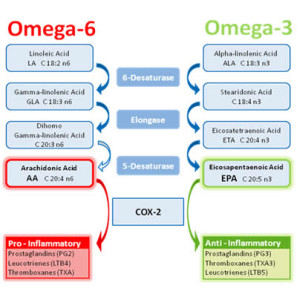
Why Essential Fats are Essential
Posted October 29, 2013 | Nutrition & Health TipsAll the craze in the 90’s said that fats were bad, and now we cannot hear enough about “good fats”. It’s true, fats are good, some essential. They are referred to as essential due to the fact that the body cannot make them itself. Instead, we must consume these essential fatty acids (EFA’s) from our diet. In that sense they could be considered a vitamin and at one point were even known as vitamin F.
There are two main types of EFA’s: omega-3 and omega-6. Omega-6 is very common in standard American diets and can be found in nuts, seeds and vegetable oils such as canola often used in cookies, crackers, and sweets. Omega-3 fats, on the other hand, are frequently lacking in the average person’s diet. These fats can be found mainly in a variety of fish such as salmon, sardines, cod liver, etc., but can also be found in nuts and plants such as walnuts, flax and evening primrose oil.
The fanfare of these oils comes from the dramatic impact they have on the body seen through research. Omega-3 acids are considered the “good fats” for reasons we will discuss in a moment, and have been shown to reduce blood pressure, decrease clots, lower cholesterol, increase brain function, regulate blood sugar, mediate the immune system and promote healthy inflammation. These oils act as precursors for different forms of oil in our body, which allow for all of these effects. See the image below.
As you can see, omega-6 oils make something called arachidonic acid. This molecule is known for its inflammatory role in the body and goes on to make a product called cyclo-oxygenase (COX) enzyme. This is exactly what common pain relievers such as Tylenol work to inhibit because it is the COX enzyme that creates the pain message. However, as you see, Omega-3 acids do not produce arachidonic acid, decreasing the pain and inflammation that is produced. Furthermore, EPA, an omega-3 by-product, also competes with the arachdonic acid to decrease any activity of arachidonic acid that is present.
The by-products of these oils have been shown to have a major role in regulating immune function. Not enough immune function can lead to illness, but too much immune function can also lead to auto-immune disease. EFA’s make up the membranes of every single cell of every tissue, organ, or part of the body. Cells are how different parts of the body communicate to each other through release or uptake of different molecules. With “good fats” making up the membranes of our cells, studies have shown that the reactivity of the immune system is optimally promoted for proper balance.
Two particular by-products of omega-3 have been shown to be critical for brain health: EPA and DHA. In a research study where they assessed blood level for amounts of the two forms of omega’s, those with lower EPA and DHA had “older brains”. In addition those individuals performed poorly on exams measuring visual memory, executive function, and abstract thinking. These findings have been linked to the effects of omega-3’s on brain inflammation and vasculature health.
While as I mentioned, EFA’s are found in every part of the body, an area of abundance and of current interest is the prostate. In fact, a by-product of the oils, prostaglandins, were named so due to the vast amount found in the prostate. A recent study claimed that slightly higher omega-3 levels were associated with increased risk for prostate cancer. This claim has many flaws in the research methods and calculations that were used to determine this insight. It was a single blood draw that showed slightly higher omega-3 levels. In addition family predisposition for prostate cancer, and history of other diseases was not taken into consideration that are known risk factors for increased risk of prostate cancer. There are many other studies before and after this study that demonstrate the benefit of omega-3’s in prostate health.
Now you may be wondering what is the best way to get your EFA’s. The best way is always straight from the diet of wild, toxin free fish, but concentrated supplements are often utilized. For vegetarians who decide to decline fish product intake, as mentioned, there are plant sources including, walnut, flax seed and evening primrose. The one thing to remember with taking a plant source for omega-3 is that there is an additional conversion step needed in the body to get it to a useful form. Unfortunately, studies have shown that this conversion is decreased in many individuals and therefore the impact of intake from these sources for some may not be as pronounced. For further information or to find out if taking fish oil is right for you and the correct levels of each component specific for your needs, talk to your physician or come see us at Vital Kids Medicine (also now seeing adults).
Works Cited:
Davis, B. R. (2010, February). Vegetarian Challenge- Optimizing Essential Fatty Acid Status. Retrieved October 2013, from Today’s Dietician: http://www.todaysdietitian.com/newarchives/020810p22.shtml
Faloon, W., Huber, L. N., Schmid, K. N., Gossard, B., & Fogle, S. N. (2013). Fish and Prostate Cancer Risk: Fact or Fiction? Retrieved October 2013, from Life Extension: http://www.lef.org/featured-articles/fish-and-prostate-Cancer-Risk-Fact-or-Fiction.htm
Gaby, A. R. (2011). Nutritional Medicine. Concord: Fritz Perlberg Publishing.
Higdon, J. P., & Drake, V. P. (2012, January 27). Micronutrient Information Center: Essential Fatty Acids: Summary. Retrieved October 2013, from Linus Pauling Institute: http://lpi.oregonstate.edu/infocenter/othernuts/omega3fa/
Kollias, H. (n.d.). Research Review: How do omega-3 acids work? Retrieved October 2013, from Precision Nutrition: http://www.precisionnutrition.com/how-o3s-work
More Evidence that OMega-3 FAtty Acids Support Brain Health. (2012, March 02). Retrieved October 2013, from Institute for Memory Impairments and Neurological Disorders, University of California: http://www.alz.uci.edu/more-evidence-that-omega-3-fatty-acids-support-brain-health/
Zurier, B. (1991). Essential Fatty Acids and Inflammation. Annals o Rheumatic Disease , 50, 745-746.

Kids Seasonal Immunity & the Influence of Nutrition
Posted October 14, 2013 | Nutrition & Health TipsIntroduction
Fall brings many changes— the weather cools down, the leaves turn pretty colors, and kids are back in school participating in lots of new activities. This transitional time can leave children more susceptible to illness. Fun fact: the average preschooler brings home around nine colds each year and kindergarteners have around 12 colds per year. So what can we do for our kids to prevent them from getting sick to begin with?
Maintaining a healthy immune system is your child’s best defense against getting sick this season. By having a well-nourished body through good nutrition with lots of healthy exercise and rest will help keep germs away.
What is the immune system?
The immune system is not just one organ or type of cell; it is the coordination and synchronization of a number of specialized cells, proteins, tissues, and organs that act together as a system. This system is the body’s defense against foreign invaders and infectious organisms (such as bacteria, viruses, and allergens). The first responders of the immune system are the white blood cells, also called leukocytes. These cells circulate through the body seeking out foreign antigens that can cause damage. To function well, our immune systems require the help and support of a healthy diet providing lots of vitamins, minerals, antioxidants, and bioactives. The dietary “helpers” allow the immune system to coordinate appropriately and protect the body from harm.
How does nutrition influence immunity?
Since our immune system requires the help of certain nutrients to function adequately, a healthy diet comprised of unprocessed whole foods is the key to fighting infection and disease prevention. Here are some basic ways nutrition can affect immunity:
- Protein deficiency can lead to decreased white blood cell function and cytokine production.
- Vitamin deficiencies can alter and impair the immune response in many ways. For example, a deficiency in vitamins A or D can reduce the immune cells’ ability to identify and respond to antigen invaders. Deficiencies in any of the B-vitamins can reduce the amount and action of white blood cells and can alter the metabolism of cytokines and antibodies.
- Excessive sugar intake leads to imbalanced blood glucose, promotes inflammation, and reduced immune response.
- Processed foods are often devoid of essential nutrients and bioactives and contain artificial chemicals that disrupt our immune defenses. They can also alter part of our body’s first line of defense (our digestive tract) and cause issues such as food sensitivities, inflammation, leaky gut, and dysbiosis.
For optimal nutrition, try to increase your child’s consumption of whole unprocessed foods- fresh organic fruit and vegetables, pasture-raised meat and eggs, wild-caught fish, whole grains, beans & legumes, nuts & seeds, and plenty of water. Sometimes kids can be picky eaters and will often turn up their noses to new “healthy” foods. Try to get creative and experiment with different foods to find nutritious options that your kids will enjoy. Their immune system will thank you!
Immune Strengthening Shiitake Miso Soup
Ingredients:
1 teaspoon extra-virgin olive oil
1 onion, thinly sliced
½ teaspoon sea salt
1 small carrot, cut into julienne or matchstick-size pieces
6 shiitake mushrooms, stems removed and discarded, caps sliced thin
2 kale leaves, stems removed and leaves shredded
1 teaspoon wakame crumbles
3 cups hot Bone Broth or hot water
3 tablespoons naturally fermented miso
1 scallion, chopped fine for garnish
Directions:
1. In a medium soup pot, sauté the onion with sea salt in olive oil for 2-4 minutes, or until almost translucent.
2. Add the carrot and continue to cook for 1 more minute. Add the mushrooms and kale and cook for 2 more minutes, until all the vegetables are soft.
3. Pour the hot broth or water into pot and add the miso and wakame.
4. Stir until miso is dissolved and incorporated. Serve in bowls and garnish with scallion.
Variation: For a heartier soup, add tofu, cooked fish, quinoa, or brown rice. Miso soup is also excellent with leftover starchy vegetables such as squash, rutabaga, sweet potatoes, etc.









